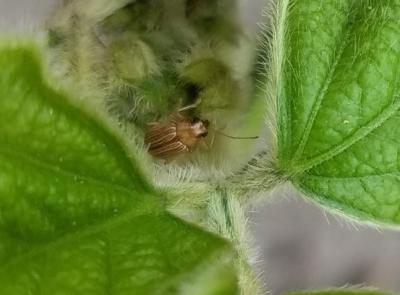URBANA, Ill. – Illinois farmers planting corn and soybeans this season will want to keep a sharp eye out for pests and diseases that made headlines in 2018, according to University of Illinois crop scientists.
Tar spot reached epidemic proportions in Midwest corn fields in 2018, says Nathan Kleczewski, field crop pathologist in the Department of Crop Sciences at U of I. He says scouting will be critical, especially in areas north of I-90 in Illinois, where the disease was most severe last year.
“Increased severity likely means increased local inoculum for this season,” he says. “If you are planting corn in a region that was hit hard by tar spot last season, your risk for disease is elevated compared to areas where disease was sparse or absent.”
Kleczewski notes that planting corn after soybean or into tilled fields could reduce the incidence of the disease, compared with planting into corn residue. He also emphasizes that scouting will be most important in the days and weeks approaching tasseling, when fungicides can still be effective.
“If you notice tar spot showing up prior to tasseling, a fungicide may help. There are several products with a label or 2ee recommendations for tar spot suppression. Like rusts, this is an obligate fungus, and you want to ensure that the ear leaf and leaves above are protected during the critical periods of grain fill. You do not want to chase this disease; revenge sprays will not work,” he says.
Although tar spot was the big news in 2018, Kleczewski notes that grey leaf spot was by far the most severe and widespread disease in corn last year. He cautions that farmers should not lose sight of this disease and others that are encountered more frequently and consistently in Illinois.
Nick Seiter, field crop entomologist in the Department of Crop Sciences at U of I, cautions farmers to keep an eye out for a pest that wreaked havoc in 2018.
“Grape colaspis is a common insect, but it only occasionally affects corn and soybean production in Illinois. However, 2018 was that rare year where ‘outbreak’ levels of infestation occurred in parts of the state, resulting in stand reductions and, in some cases, replanting of damaged areas,” he says.
Adults, which resemble bean leaf beetles, lay eggs in the soil in soybean, alfalfa, and legume fields in the summer. Larvae overwinter and do the greatest damage to roots in the spring, leading to stand reduction.
Seiter says chemical control measures for grape colaspis must be applied at planting. Insecticide seed treatments have been used successfully for grape colaspis control in rice in the southern U.S., but he says there is little information to assess the effectiveness of these treatments in the Midwest.
“Because of the sporadic nature of this pest in corn and soybean, there are limited data available for at-plant control options here. Consider soil insecticides or insecticide seed treatments on fields that have a history of grape colaspis damage, referring to the label for correct use,” he says.
Seiter notes there are no viable rescue treatments for grape colaspis; instead, once damage has occurred, the only management decision is whether or not to replant.
“Remember, this insect is sporadic in Illinois; history suggests that issues in 2018 do not necessarily translate to another big year in 2019,” he says. “Hopefully, this one will pass us by this season, but learn to recognize this insect and its damage just in case.”
Read more about tar spot, grape colaspis, and more in the Bulletin, a pest management and crop development publication from the University of Illinois.
Sources: Nathan Kleczewski, 217-300-3253, nathank@illinois.edu; Nick Seiter, 217-300-7199, nseiter@illinois.edu
News writer: Lauren Quinn, 217-300-2435, ldquinn@illinois.edu
Source: Nathan Michael Kleczewski, Research Assistant Professor, nathank@illinois.edu
